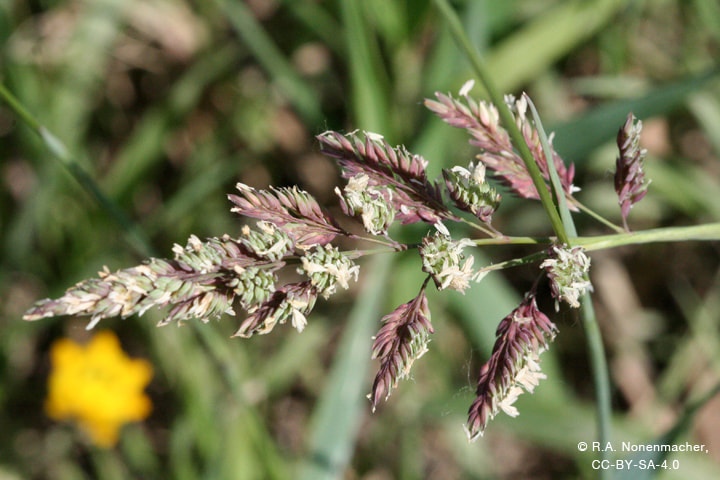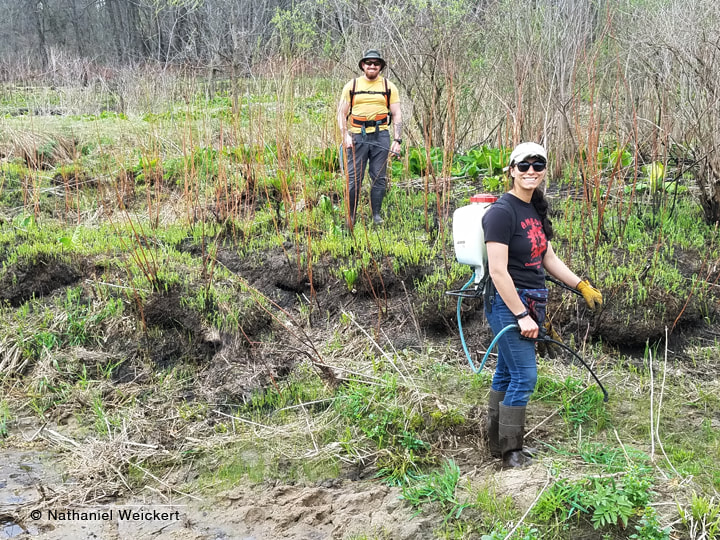|
By Mary Meier Nachusa Grasslands volunteer Each May, Nachusa Grasslands’ staff and stewards usually dread the appearance of one of our major weed adversaries, reed canary grass (Phalaris arundinacea — RCG). This year, however, we may welcome the opportunity to attack the invaders, if and when we are released from our “stay at home” restrictions. The prospect of heading out into the field laden with herbicide backpacks is very appealing right now. What is reed canary grass? RCG is a coarse, cool-season perennial grass with erect hairless stems that grow from 2 to 6 feet tall. Densely clustered single flowers at the top of each plant change from green to purple to tan in late spring. Shiny dark brown seeds form during the summer months and shatter easily. Reproduction takes place both by seed dispersal and underground rhizomatous roots that create a thick, impenetrable mat just under the soil. Seeds can float down waterways and also spread via animals, humans, or machines. For example, Nachusa’s bison and deer populations may brush up against the plants and then carry the seeds in their fur. Where does reed canary grass grow? The plants thrive in moist areas, including marshes, swamps, prairies, meadows, fens, stream banks, and swales. It is especially abundant in disturbed wetlands, but can also appear in high quality native habitat. How did reed canary grass arrive in northern Illinois? Since the 1800s, agronomists have encouraged planting RCG for forage and erosion control. Some states prohibit selling the seeds, but Illinois does not. A native species actually exists, but it is almost impossible to distinguish from the more aggressive Eurasian variety. At Nachusa Grasslands we strive to eradicate all occurrences of RCG in order to diminish its ecological threats. Why does reed canary grass cause problems in our natural areas? RCG forms large monocultures, crowding out native species and building up a tremendous seed bank that germinates year after year. The thick thatch that forms from rhizomes and collapsed stems is especially problematic, as it prevents more desirable seeds from germinating. RCG, therefore, reduces native plant and insect diversity, while providing little shelter or food for wildlife. How do we manage reed canary grass at Nachusa Grasslands? Spraying grass herbicide is our main approach. The staff and stewards treat RCG with Intensity, a post-emergence grass herbicide (1% clethodim). Even though clethodim does not kill the plants’ roots, it helps set back the grasses and allows sedges and forbs to move in. Around waterways and high-quality natural areas, the crew uses the same formula with extra caution to reduce overspraying. What are some other reed canary grass control methods? Research and experience show that burning and mowing can actually stimulate regrowth of RCG but may also be useful in removing thatch prior to overseeding. Digging up rhizomes is labor-intensive and disturbs the soil, so other weeds may then invade the site. In small patches, cutting off the seed heads and disposing them off-site can be effective when combined with herbicide application. Covering with shade cloths is another option for large infestations. As with all weed management projects, best practices depend on overall goals and objectives, the size, distribution, and location of RCG infestations, willingness to use herbicides, and available human and equipment resources. In addition, every method requires follow-up monitoring, treatment, and establishing native species as we strive to extirpate this very challenging invasive species. Mary Meier has been a dedicated volunteer at Nachusa since 2002. She is currently an officer for Friends of Nachusa Grasslands, an Autumn on the Prairie festival organizer, and a member of the social media team. Along with her husband Al, she stewards the Dot and Doug Wade Prairie Unit, which is about half restoration and half remnant.
3 Comments
Hugh Frisbie
5/4/2020 09:23:37 am
Have you ever tried mowing stands of RCG in September and then spraying with glyphosate I late October or November after hard frosts? The RCG is still green and most of the natives have gone dormant. I’ve tried this in a few test plots, and it seems to have been very successful the next year. Still has a seed bank that will come up, but seems to kill the roots.
Reply
4/19/2022 08:23:44 am
In other parts of the world, where RCG is native, does it have any natural predators? For example, do any animals naturally eat RCG?
Reply
Mary Meier
4/21/2022 08:06:26 pm
See https://www.canr.msu.edu/news/reed_canarygrass_love_it_or_hate_it
Reply
Your comment will be posted after it is approved.
Leave a Reply. |
Blog CoordinatorDee Hudson
I am a nature photographer, a freelance graphic designer, and steward at Nachusa's Thelma Carpenter Prairie. I have taken photos for Nachusa since 2012. EditorJames Higby
I have been a high school French teacher, registered piano technician, and librarian. In retirement I am a volunteer historian at Lee County Historical and Genealogical Society. Categories
All
Archives
January 2024
|
CONNECT WITH US |
|







 RSS Feed
RSS Feed